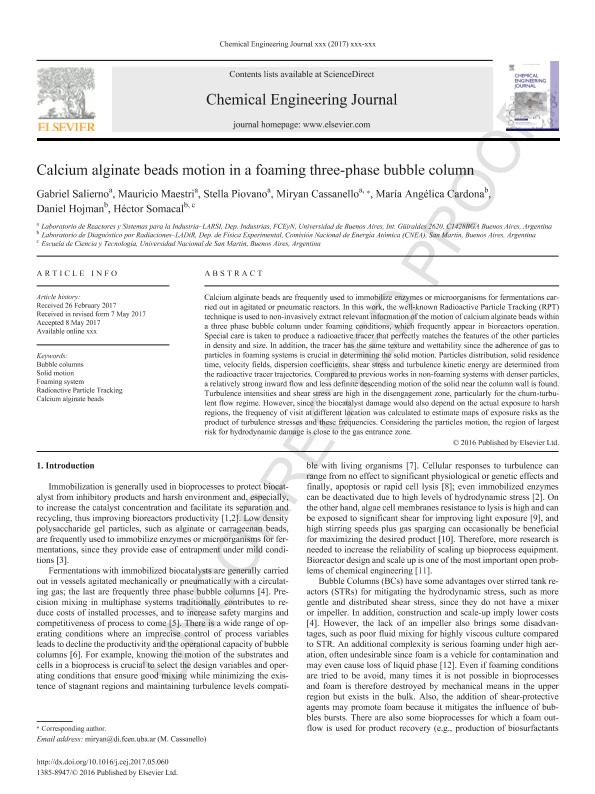Mostrar el registro sencillo del ítem
dc.contributor.author
Salierno, Gabriel Leonardo

dc.contributor.author
Maestri, Mauricio Leonardo

dc.contributor.author
Piovano, Stella Maris

dc.contributor.author
Cassanello Fernandez, Miryam Celeste

dc.contributor.author
Cardona, Maria Angelica

dc.contributor.author
Hojman, Daniel Leonardo

dc.contributor.author
Somacal, Héctor Rubén

dc.date.available
2018-09-18T20:05:15Z
dc.date.issued
2017-05
dc.identifier.citation
Salierno, Gabriel Leonardo; Maestri, Mauricio Leonardo; Piovano, Stella Maris; Cassanello Fernandez, Miryam Celeste; Cardona, Maria Angelica; et al.; Calcium alginate beads motion in a foaming three-phase bubble column; Elsevier Science Sa; Chemical Engineering Journal; 324; 5-2017; 358-369
dc.identifier.issn
1385-8947
dc.identifier.uri
http://hdl.handle.net/11336/60147
dc.description.abstract
Calcium alginate beads are frequently used to immobilize enzymes or microorganisms for fermentations carried out in agitated or pneumatic reactors. In this work, the well-known Radioactive Particle Tracking (RPT) technique is used to non-invasively extract relevant information of the motion of calcium alginate beads within a three phase bubble column under foaming conditions, which frequently appear in bioreactors operation. Special care is taken to produce a radioactive tracer that perfectly matches the features of the other particles in density and size. In addition, the tracer has the same texture and wettability since the adherence of gas to particles in foaming systems is crucial in determining the solid motion. Particles distribution, solid residence time, velocity fields, dispersion coefficients, shear stress and turbulence kinetic energy are determined from the radioactive tracer trajectories. Compared to previous works in non-foaming systems with denser particles, a relatively strong inward flow and less definite descending motion of the solid near the column wall is found. Turbulence intensities and shear stress are high in the disengagement zone, particularly for the churn-turbulent flow regime. However, since the biocatalyst damage would also depend on the actual exposure to harsh regions, the frequency of visit at different location was calculated to estimate maps of exposure risks as the product of turbulence stresses and these frequencies. Considering the particles motion, the region of largest risk for hydrodynamic damage is close to the gas entrance zone.
dc.format
application/pdf
dc.language.iso
eng
dc.publisher
Elsevier Science Sa

dc.rights
info:eu-repo/semantics/openAccess
dc.rights.uri
https://creativecommons.org/licenses/by-nc-sa/2.5/ar/
dc.subject
Bubble Columns
dc.subject
Calcium Alginate Beads
dc.subject
Foaming System
dc.subject
Hydrodynamic Stress
dc.subject
Radioactive Particle Tracking
dc.subject
Solid Motion
dc.subject.classification
Otras Ingeniería Química

dc.subject.classification
Ingeniería Química

dc.subject.classification
INGENIERÍAS Y TECNOLOGÍAS

dc.title
Calcium alginate beads motion in a foaming three-phase bubble column
dc.type
info:eu-repo/semantics/article
dc.type
info:ar-repo/semantics/artículo
dc.type
info:eu-repo/semantics/publishedVersion
dc.date.updated
2018-09-17T19:27:19Z
dc.journal.volume
324
dc.journal.pagination
358-369
dc.journal.pais
Países Bajos

dc.journal.ciudad
Amsterdam
dc.description.fil
Fil: Salierno, Gabriel Leonardo. Consejo Nacional de Investigaciones Científicas y Técnicas; Argentina. Universidad de Buenos Aires. Facultad de Ciencias Exactas y Naturales. Departamento de Industrias; Argentina
dc.description.fil
Fil: Maestri, Mauricio Leonardo. Consejo Nacional de Investigaciones Científicas y Técnicas; Argentina. Universidad de Buenos Aires. Facultad de Ciencias Exactas y Naturales. Departamento de Industrias; Argentina
dc.description.fil
Fil: Piovano, Stella Maris. Universidad de Buenos Aires. Facultad de Ciencias Exactas y Naturales. Departamento de Industrias; Argentina
dc.description.fil
Fil: Cassanello Fernandez, Miryam Celeste. Consejo Nacional de Investigaciones Científicas y Técnicas; Argentina. Universidad de Buenos Aires. Facultad de Ciencias Exactas y Naturales. Departamento de Industrias; Argentina
dc.description.fil
Fil: Cardona, Maria Angelica. Consejo Nacional de Investigaciones Científicas y Técnicas; Argentina. Comisión Nacional de Energía Atómica; Argentina
dc.description.fil
Fil: Hojman, Daniel Leonardo. Consejo Nacional de Investigaciones Científicas y Técnicas; Argentina. Comisión Nacional de Energía Atómica; Argentina
dc.description.fil
Fil: Somacal, Héctor Rubén. Comisión Nacional de Energía Atómica; Argentina. Universidad Nacional de San Martín. Escuela de Ciencia y Tecnología; Argentina
dc.journal.title
Chemical Engineering Journal

dc.relation.alternativeid
info:eu-repo/semantics/altIdentifier/doi/https://dx.doi.org/10.1016/j.cej.2017.05.060
dc.relation.alternativeid
info:eu-repo/semantics/altIdentifier/url/https://www.sciencedirect.com/science/article/pii/S1385894717308094
Archivos asociados
